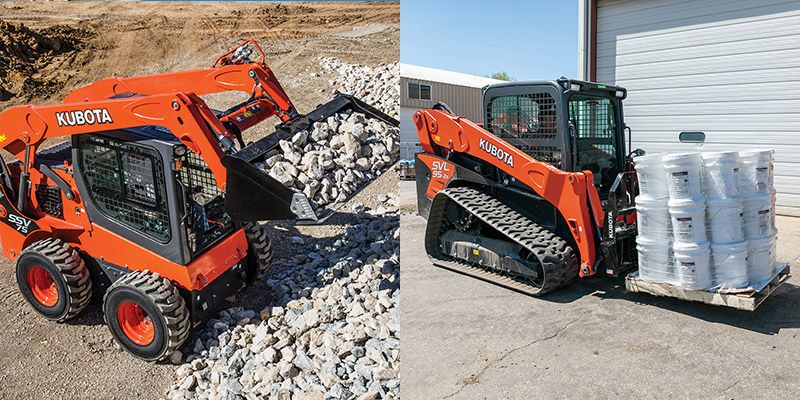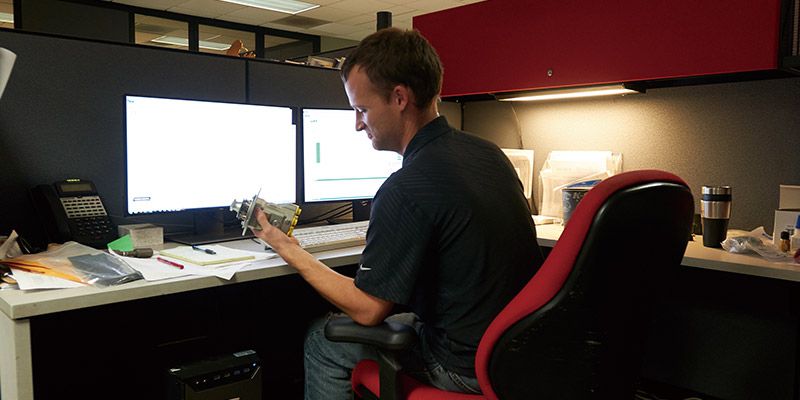06
Kubota’s Construction Machinery Business Accelerating Multi-Dimensional
Expansion
- A new partnership delivers added momentum. -

Leveraging each other’s strengths

President & CEO
Great Plains Manufacturing, Inc.
A major watershed in the recent development of Kubota’s construction machinery business came in 2016, when Great Plains Manufacturing, Inc. (GPM) joined the Kubota Group. Founded in 1976 in Salina, Kansas, U.S., GPM has since garnered a solid reputation in North America for its manufacturing of advanced farm implements and construction attachments, which perform all kinds of jobs by drawing power from agricultural and construction machinery. One can use a single construction machine to do more than a single job—digging, transporting, and drilling—by choosing from among a wide variety of attachments to perform the task at hand. As such, construction machinery and attachments are inseparable, and their specifications need to match perfectly to yield maximum performance; hence, Kubota and GPM agreed to join hands together.
This symbiotic relationship did not come about in a day—GPM was already one of the key business partners for Kubota back in the 1980s, and this working relationship deepened in 2007, when the two companies signed a marketing alliance agreement for farm implements. At that time, Kubota’s focus in the U.S. market was the marketing of its compact tractors. The alliance with GPM allowed Kubota to stably procure implements that were a great fit for its tractors, which boosted Kubota tractors’ appeal to American customers. For GPM, on the other hand, the alliance meant a significant expansion of sales channels, as they were able to distribute their implements through Kubota’s dealer network. The two companies have since fostered an optimal partnership as they each tap into their own strengths for mutual benefit. The same benefits soon became apparent in Kubota’s construction machinery business. In 2014, GPM began production of attachments for compact construction machinery, which coincided with the period when Kubota was about to take the offensive in the U.S. market with its newly developed compact track loaders (CTLs) and skid steer loaders (SSLs). Now, Kubota-branded attachments are available in the U.S. market, and bundled sales of construction machines and attachments that cater to individual user needs have made a significant contribution to the growth of the construction machinery business. “We now offer as many as 40 kinds of attachments, up from only five or so. This is definitely because we worked closely with Kubota to develop and launch new products. We are seeing growth in terms of both quality and quantity, so much so that our attachment sales are expanding rapidly,” said Linda Salem, President & CEO, Great Plains Manufacturing, Inc. “I feel that our customers rate us so highly because alongside Kubota, we deliver reliable products of good quality, together with a one-stop service from development to manufacturing and distribution, as well as after-sales service and follow-ups that make the most of Kubota’s extensive dealer network.”
-

Great Plains Manufacturing, Inc. -

Manufacturing attachments for construction machinery. Built one by one with utmost care. -

Manufacturing attachments for construction machinery. Built one by one with utmost care.
Cultural affinity between GPM and Kubota

President, Land Pride Division
Great Plains Manufacturing, Inc.
When the alliance between Kubota and GPM began to get into gear, the founder of GPM was seeking a buyer for the business in anticipation of his imminent retirement. Topping the list of candidates was none other than Kubota. First and foremost, Kubota was a strategic partner with which they had fostered a good relationship. However, the single biggest decisive factor was the affinity between the two companies’ corporate philosophy; namely, treating their customers and employees with the utmost care. John Quinley, President, Land Pride Division, GPM, says that this sort of integration is quite different from that which results from the common acquisition of businesses in the U.S.
“In the U.S., when your company is taken over by someone, more often than not the acquiring party asks for sweeping changes, such as divestment of business and drastic restructuring. Kubota is not like that. They respect GPM’s business and let us do things our way as much as possible. In fact, we don’t have any barriers between us, and we maintain close communication. Because Kubota ensures continuity of GPM’s business and invites us to literally “collaborate,” we have created a new corporate culture of enhancing our respective businesses as we work together. I have to reiterate that this rarely happens in corporate acquisitions. Going forward, we will continue to deepen our relationship, so that we can achieve expansion of the Kubota Group’s construction machinery business together.” (Quinley)
-

SSL moving rocks (left) and CTL moving materials (right). With different attachments, SSL and CTL serve versatile applications.
The epitome of synergy

Executive Coordinator
CE Product Development and Quality
Management
Kubota North America Corporation
Three years after the two companies started down their shared corporate path, synergy from the integration has begun to show in various ways - be it on the manufacturing f loor or in terms of corporate governance. One such way that Salem hails as a “very exciting collaboration” is a joint project for product development, where GPM plays the leading role with support from Kubota. Sent from Japan to support the project was Toshihiko Takemura, an expert in the development of compact construction machinery who once led the development of CTLs and SSLs.
“When I first arrived here, I had no idea how GPM would respond to our first-ever joint development project. But my concerns proved to be unfounded when I briefed my counterparts from GPM on the project. From the gleam in their eyes, I could see excitement about the challenge and a high degree of motivation. I was instantly convinced that this would work.” (Takemura)
As Takemura and engineers from GPM lost no time in analyzing competitors’ products on the market and carrying out repeated market surveys, a new product began to take shape. As a result of possessing different product ranges, the two companies have different sets of proprietary technologies in which they excel. By fully utilizing their respective strengths in the product development process and applying GPM’s f lexible approach, which they had taken to expand the product line rapidly, the challenge of the project was overcome with f lying colors.
“This project marks a milestone in that it is the very first attempt by Kubota’s construction machinery business to develop new products from scratch outside of Japan. Now, the fundamental characteristic of Kubota’s manufacturing is to see things from the viewpoint of the people that actually use our products. If you want to develop a product that is adored in the U.S., you can make it competitive by incorporating American sensibilities and ideas. Expanding the product line in the U.S. market is imperative for us. That being the case, this joint development project is all about attempting to promptly launch a series of products that the market really desires by making the most of the Kubota Group’s resources.” (Takemura)
Kubota’s construction machinery business in the U.S. market has moved to a new phase by joining forces with GPM. The “developedin-America” project that Takemura is engaged in should act as a touchstone for the future course of Kubota’s construction machinery business in the U.S. It is safe to say that Kubota’s construction machinery business has been going strong following the market debut of CTLs. Yet, the business environment is so changeable that anyone can drop out instantly if they fail to keep their ear to the market. To achieve sustained development of the construction machinery business, Kubota keeps challenging itself ever more aggressively.
-

A young engineer developing a new product on a computer